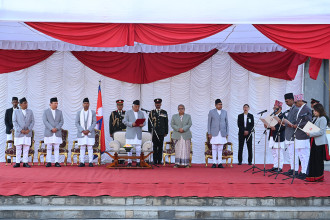-1761646468.jpeg)
KATHMANDU: Nepal Institute for International Cooperation and Engagement (NIICE) organised a public lecture on 'Rising power competition: Indian and Chinese commercial landscapes in the Indo‑Pacific' at the NIICE Seminar Hall in Lalitpur on Tuesday.
Daniel Loebell, a PhD candidate in political science at Northwestern University in the United States, delivered the lecture and emphasised how strategic and economic rivalry between India and China is reshaping the Indo‑Pacific and influencing smaller South Asian states, including Nepal and Malaysia.
Addressing the event, Bibek Dhoj Thapa, programme coordinator at NIICE, explained NIICE’s research focus within the Indo‑Pacific framework, referring to work by Dr Pramod Jaiswal, NIICE’s research director. Thapa said Nepal can be viewed as a “virtual maritime country” because of its open border with India and its affiliation with BIMSTEC, which he said provides access to the Indian Ocean. He added that competition between India and China in the Indo‑Pacific waters shows spillover effects in the Himalayan region where Nepal is situated.
-1761646468.jpeg)
-1761646467.jpeg)
-1761646468.jpeg)
Thapa observed that as India strengthens maritime partnerships, particularly with the United States, China has adopted a more assertive posture along their shared Himalayan border. “Tensions in the Indo‑Pacific waters are mirrored in the Himalayas,” he said, emphasising that the Himalayan region and the Indian Ocean are interlinked arenas of great‑power competition.
Loebell reflected on his fieldwork in Nepal, drawing on more than 40 semi‑structured interviews with officials, academics and private‑sector representatives. His preliminary findings indicate that India’s commercial and institutional influence in Nepal remains more pervasive than China’s, particularly in trade, investment and non‑profit exchanges, and he said these patterns show how small states navigate complex economic pressures from multiple regional powers.
Loebell said Nepal’s position between India and China allows it to serve as a strategic observation point for scholars studying the balance of power in South Asia. He described his research as “exploratory fieldwork on how small states hedge between large powers to protect their sovereignty while engaging economically.”
He also highlighted historical links that shape contemporary relations, saying Nepal’s position between northern India and Tibet fostered centuries of cultural, trade and migratory interactions, later influenced by the British colonial era and restrictions under the Rana regime that prompted Nepalis to go abroad, including to Malaysia. He said Malaysia presents an older layer of transregional engagement, tracing connections nearly 900 years to the Kedah city‑state and its links to China via the Chola Empire of Tamil Nadu. Loebell referred to historical trade networks, including a “Group of 500” merchants managing spice and raw‑material exchanges across the Indian Ocean to China, as examples of early globalisation.
Loebell credited the Northwestern Buffett Institute for International Studies for supporting his research and fieldwork across South Asia, including lectures in Sri Lanka, India and Nepal. He concluded by stressing the importance of academic collaboration between Nepali and international institutions to better understand the region’s shifting political economy.
The session concluded with an interactive question-and-answer segment on strategic opportunities for Nepal and Malaysia within the broader Indo‑Pacific discourse. Around 20 participants attended, including researchers, academics, diplomats, students and think‑tank representatives.






-1765524551.jpeg)